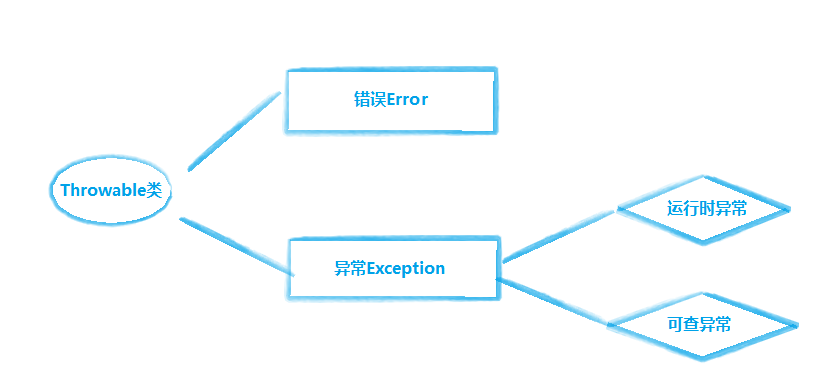学习内容:
1.异常:
异常是会打断程序正常运行的事件。
继承关系:Throwable是超类,其继承类为Error,Exception。
常见的Error有StackOverflowError、OutofMemery错误,Error会直接打断整个程序运行,没有方法处理。
Exception:分为运行时异常、编译时异常(可查异常),其中运行时异常不强行要求处理异常,而编译时异常必须处理,要么try catch住,要么往外抛,否则编译无法通过。

异常报错过程:JVM检测到异常,实例化一个含异常信息的异常类,向调用者抛出异常,如果调用者未作处理,则抛向main方法,如果main方法也未作处理,则抛给JVM,JVM打印错误信息。
2.异常处理:
(1)try catch,在方法体内使用
public class Test { public static void main(String[] args){ SimpleDateFormat sf = new SimpleDateFormat("yyyy-MM-dd"); try { Date d1 = sf.parse("2018-04-22"); } catch (ParseException e) {//可查异常,必须处理,要么try catch住,要么往外抛 System.out.println("日期格式错误!");//异常未被抛出,只是打印语句,不打断程序运行 } catch (Exception ex) {//平级异常、子类异常在前,父类异常在后 System.out.println(ex); } } }
public class Test { public static void main(String[] args){ SimpleDateFormat sf = new SimpleDateFormat("yyyy-MM-dd"); try { int[] a = {1,2}; System.out.println(a[3]); } catch (ArrayIndexOutOfBoundsException e) {//运行时异常,可以不处理,这里选择处理,并抛出异常 throw new ArrayIndexOutOfBoundsException("下标越界"); } } }
运行时异常可以不try catch,可以直接抛出
public Test{ public static double getArea(double r) { if(r<=0) { throw new RuntimeException("错误的半径!"); } return Math.PI*r*r; } }
(2)throws
直接抛出错误:
public class Test { public static void main(String[] args) throws ParseException { SimpleDateFormat sf = new SimpleDateFormat("yyyy-MM-dd"); Date d1 = sf.parse("2018-04-22"); } }
(3)throw和throws的区别:
1. throws 出现在方法声明上,而throw通常都出现在方法体内。
2. throws 表示出现异常的一种可能性,并不一定会发生这些异常;throw则是抛出了异常,执行throw则一定抛出了某个异常对象。
(4)多异常处理时的注意事项:
平级异常、子类异常在前,父类异常在后。
(5)继承类异常处理问题:
public class Fu { public void method() throws NullPointerException{} public void me() {} } public class Zi extends Fu{ /*public void method() {}*/ //子类重写可以不抛异常 /*public void method() throws NullPointerException {}*/ //如果要抛异常,则抛出的异常要与父类相同或者是父类抛出的的异常的子类 //public void me() throws Exception{} //如果父类的方法没有抛异常,则子类也不可以抛出异常,如果子类重写的方法需要处理异常, //则只能 try catch }
(6)try catch finally
public Test{ public static void t(int[] a) { try { System.out.println(a[3]); } catch (Exception e) { System.out.println(e); }finally {//无论是否发生异常都会执行 a = null; //通常用来释放资源 } } }
3.自定义异常
可以指定抛出的异常语句
public class FException extends RuntimeException{ public FException() {}; public FException(String message) { super(message); } } public class Test { public static void main(String[] args) { System.out.println(test(-2.5)); } }
4.Throwable常用方法:
getMessage:返回异常信息
toString:放回异常类名和异常信息
printStackTrace:在控制台打印异常类名、异常信息、出现位置